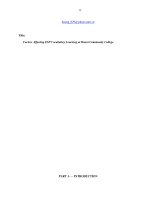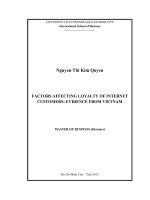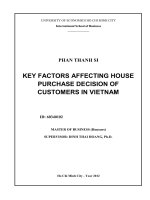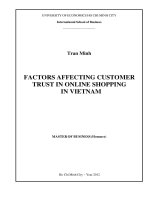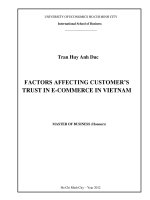Factors affecting employee antisocial behavior at vietnam airline
Bạn đang xem bản rút gọn của tài liệu. Xem và tải ngay bản đầy đủ của tài liệu tại đây (1.41 MB, 58 trang )
RESEARCH PROJECT
(BMBR5103)
FACTORS AFFECTING
EMPLOYEE ANTISOCIAL BEHAVIOR AT
VIETNAM AIRLINE
STUDENT’S FULL NAME
: DANG DANH THU
STUDENT ID
: CGS00018513
INTAKE
: SEPT 2014
ADVISOR’S NAME & TITLE
: NGUYEN THE KHAI, DBA
December 2015
ADVISOR’S ASSESSMENT
..............................................................................................................................
..............................................................................................................................
..............................................................................................................................
..............................................................................................................................
..............................................................................................................................
..............................................................................................................................
..............................................................................................................................
..............................................................................................................................
..............................................................................................................................
..............................................................................................................................
..............................................................................................................................
..............................................................................................................................
..............................................................................................................................
..............................................................................................................................
..............................................................................................................................
..............................................................................................................................
..............................................................................................................................
..............................................................................................................................
Advisor’s signature
Nguyen The Khai, DBA
2
ACKNOWLEDGEMENTS
Firstly, I would like to express my sincere thanks and deep gratitude to all of the
teachers of Hutech University and Open University Malaysia teaching, imparting
knowledge to us during the study period.
Secondly, I acknowledge with gratitude to Dr. Nguyen The Khai, who has always
been sincere and helpful in making me understanding how to do a research and run
SPSS software. Without such detail instructions and advises, I am unable to
complete this paper of Business Research Methods.
Lastly, I also wish to express my sincere thanks to the employees of Vietnam
Airline for their precious comments and helps to collect data for this thesis.
3
Table of Contents
ACKNOWLEDGEMENTS ............................................................................................... 3
LIST OF FIGURES.......................................................................................................... 6
LIST OF TABLES ........................................................................................................... 7
ABBREVIATIONS.......................................................................................................... 8
ABSTRACT ................................................................................................................... 9
CHAPTER I - INTRODUCTION...................................................................................... 10
1.1 Company Introduction ............................................................................................ 10
1.2 Research Introduction ............................................................................................. 19
1.2.1 Problem statement .............................................................................................20
1.2.2 Purpose of the study ..........................................................................................22
1.2.3 The scope of the research ..................................................................................22
1.2.4 Research questions ............................................................................................22
CHAPTER II – LITERATURE REVIEW ............................................................................ 23
2.1 Antisocial behavior .................................................................................................. 23
2.2 Work family conflict ................................................................................................ 24
2.3 Job role ambiguity ................................................................................................... 25
2.4 Job overload ............................................................................................................ 25
2.5 Frustration with work .............................................................................................. 26
CHAPTER III: RESEACH MODEL AND HYPOTHESES ...................................................... 28
3.1 Research Model ....................................................................................................... 28
3.1.1 Dependent Variables: ........................................................................................28
3.1.2 Independent Variables: ......................................................................................28
3.1.3 Constructs ..........................................................................................................29
3.2 Research Hypotheses .............................................................................................. 29
3.3 Instruments ............................................................................................................. 32
3.4 Research Participants .............................................................................................. 33
3.5 Procedure for Data Collection and Analyze ............................................................ 34
CHAPTER IV: ANALYSIS AND RESULTS ........................................................................ 36
4.1 Reliability Analysis ................................................................................................... 36
4
4.2 Descriptive Analysis ................................................................................................. 37
4.3 Correlation of all variables statistics ....................................................................... 37
4.4 Hypotheses Testing ................................................................................................. 38
CHAPTER V: CONCLUSION ......................................................................................... 41
5.1 Summary and Discussion ........................................................................................ 41
5.2 Management Implications ...................................................................................... 42
5.3 Limitations and Further Research Recommendation ............................................. 43
REFERENCES ............................................................................................................. 44
APPENDIX ................................................................................................................. 48
5
LIST OF FIGURES
Figure 1: information regarding the workforce of Vietnam Airlines
6
LIST OF TABLES
Table 1: Summary of Cronbach‟s Alpha of the variables
Table 2: Descriptive Statistics
Table 3: Correlation among Variables
Table 4: Model Summary of all hypotheses
Table 5: Coefficients of all hypotheses
Table 6: Hypothesis Statistic
7
ABBREVIATIONS
VNA
Vietnam Airlines
SPSS
Statistical Packages for the Social Science
AB
Antisocial Behavior
WFC
Work Family Conflict
JRA
Job Role Ambiguity
JO
Job Overload
FWW
Frustration with Work
8
ABSTRACT
The objectives of this study were to investigate the factors affecting employees‟
antisocial behavior. The sample comprised of all employees working in Vietnam
Airlines. The research instruments comprised of 320 questionnaires with 33
questions. Hypothesis testing was performed by using SPSS software, Pearson
product moment correlation analyses and regression analyses. The result indicate
that as work family conflict, job role ambiguity, job overload and frustration with
work increase, so does the level of antisocial behavior. The result also shows that
work family conflict and job overload have a greater effect on antisocial behavior
than job role ambiguity and frustration with work. The implications and
limitations are also discussed at the end of the paper.
Keywords: antisocial behavior, work family conflict, job overload, job role
ambiguity, frustration with work
9
CHAPTER 1: INTRODUCTION
1.1 Company Introduction:
Vietnam Airlines JSC
200 Nguyen Son Str., Long Bien Dist., Ha Noi city, VIETNAM
Business License No 106000844 issued on Jan 26, 2007 by Hanoi authority for
Planning & Investment.
Tax Code: 0100107518
History of Vietnam Airlines:
The Vietnam Civil Aviation Department was established by the Government in
January 1956, marking the birth of the civil aviation industry in Vietnam. At that
time, the fleet was small with only five aircraft of IL-14, AN-2, Aero-45… which
started to serve domestic flights in September 1956.
April 1993, Vietnam Airlines was officially established as the country‟s
national flag carrier. On the 27th May 1995, Vietnam Airlines Corporation was
born with the gathering of 20 aviation enterprises and the airline itself as the core
business.
On 20th October 2002, Vietnam Airlines introduced the new logo of the
Golden Lotus and corporate identity that symbolized its dramatic progress towards
becoming a world-class airline. The launch represented a complete repositioning
and brand strategy of Vietnam Airlines, coupled with significant improvements in
its infrastructure, operations and fleet.
The delivery of its first own “state-of-the-art” B777 in 2003 also marked a true
revolution in the airline‟s fleet modernization. Nowadays, Vietnam Airlines
10
operates one of the most modern fleets in the region with the average age of the
fleet is 5.4 years.
For 20 years of development at an average annual growth rate consistently in
double-digit number, the national flag carrier has marked an obvious advance to
become a major competitor in the Asian aviation market, owning a modern fleet of
Airbus and Boeing planes flown by well trained professionals.
Beginning with non-regular domestic services, today Vietnam Airlines
operates to 21 cities throughout the country and 28 international destinations in
Asia, Europe, and Australia. Its network extends to 26 countries and territories.
In 2006, after being awarded the IATA Operational Safety Audit (IOSA)
certificate, a strict safety standard set by Aviation Quality Services (AQS),
Vietnam Airlines joined the International Air Transport Association (IATA) as an
official member, affirming its international standard.
In June 2010, Vietnam Airlines joined SkyTeam, the world‟s second largest
global airline alliance, affirming the carrier‟s new position on the global aviation
map as the strategic partner of the alliance in Southeast Asia region as well as its
international standard services.
Positioning its internationally recognized brand as a young and modern carrier,
Vietnam Airlines excelled further when signing large purchase orders of world‟s
most modern, environment-friendly aircraft, such as Boeing B787 and Airbus
A350-900. The airline is expected to reach 101 and 150 modern aircraft in 2015
and 2020, respectively, making solid steps integrating into the global aviation
industry as one of leading regional carrier, which is fully ingrained with
Vietnamese traditional culture.
Partners:
In order to better meet customers‟ demand and expectation, Vietnam Airlines
has been expanding its cooperation with the world‟s and regional leading airlines,
offering seamless services to an extensive global network.
11
SkyTeam 's Partners
Air
France
Code-share agreement on flights between Ho Chi Minh
City - Paris, Hanoi - Paris
Czech
Airlines
(Tentative
from
1
September
2010)
Code-share agreement on flights between Ho Chi Minh
City - Frankfurt, Hanoi - Frankfurt, Frankfurt - Prague.
Alitalia
Code-share agreement on flights between Ho Chi Minh
City - Frankfurt, Hanoi - Frankfurt, Ho Chi Minh City Paris, Hanoi - Paris, Frankfurt - Rome, Paris - Rome.
Korean Air
Code-share agreement on flights between Hanoi - Seoul,
Ho Chi Minh City - Seoul, Hanoi - Pusan, Ho Chi Minh
City
-
Pusan
12
Royal Dutch Airlines
Code-share agreement on flights between Ho Chi Minh
City - Bangkok and Amsterdam - Frankfurt.
Delta Airlines
Code-share agreement on flights between Narita - Los
Angeles, Narita - San Francisco, Narita - Atlanta, Narita Minneapolis, Narita - Seatle, Narita - Porland, Narita Honolulu, Atlanta - Dallas Ft. Worth, Atlanta - Houston,
Atlanta - Miami, Atlanta- Washington D.C, Atlanta Austin, Minneapolis - Chicago, Minneapolis - Denver,
Minneapolis - Saint Louis, Minneapolis- Boston,
Minneapolis- Philadelphia.
The other Partners
Japan Airlines
Code share agreement on flights between Hanoi - Osaka,
13
Ho Chi Minh City - Osaka, Hanoi - Narita, Ho Chi Minh
City - Narita, Hanoi – Fukuoka, Ho Chi Minh CityFukuoka, Hanoi - Nagoya, Osaka – Saporo, Osaka Haneda, Osaka – Okinawa, Nagoya – Sapporo, Narita –
Sapporo.
China Airlines
Code-share agreement on flights between Taipei - Los
Angeles, Taipei - San Francisco, Hanoi - Taipei, Ho Chi
Minh City - Kao Shiung.
Cathay Pacific
Code-share agreement on flights between Ho Chi Minh
City - Hong Kong, Hanoi - Hong Kong
Qantas Airways
Code-share agreement on flights between Ho Chi Minh
City - Sydney, Ho Chi Minh City - Melbourne
14
Philippines Airlines
Code-share agreement on flights between Ho Chi Minh
City - Manila
Garuda Indonesia
Code-share agreement on flights between Ho Chi Minh
City - Singapore, Singapore - Jakarta
Lao Airlines
Code-share agreement on flights between Hanoi Vientiane, Hanoi - Luang Prabang, Pakse - Hochiminh
City, Vientiane - Phnom Penh, Luang Prabang - Siem
Reap.
Cambodia
Angkor
Air
Code-share agreement on flights between Ho Chi Minh
City - Siem Reap, Ho Chi Minh City - Phnom Penh,
15
Phnom Penh - Siem Reap
Etihad Airways
Code-share agreement on flights between Abu Dhabi Bangkok, Abu Dhabi - Kuala Lumpur, Hanoi - Bangkok,
Ho Chi Minh City- Bangkok, Hanoi - Kuala Lumpur, Ho
Chi Minh City - Kuala Lumpur
Israel Airlines
Code-share agreement on flights between Tel Aviv Hong Kong, Hanoi – Hong Kong (one way), Ho Chi
Minh City – Hong Kong
Symbol and Logo:
Golden Lotus logo: The new logo featured one of the most enduring and
meaningful symbols of the Vietnamese people - the Lotus flower. Vietnamese
people see the lotus as a symbol of their ancient culture and their ability to
withstand great adversity and retain their unique traditions. The lotus is associated
with the enlightenment and perfection. It is a common, yet noble and sacred
flower. The gold color was chosen to show the high quality of our product and
evoke a sense of luxury.
16
On October 20th, 2002, Vietnam Airlines introduced a new logo and corporate
identity that symbolized its dramatic progress towards becoming a world-class
airline. The launch represented a complete repositioning and branding of Vietnam
Airlines, coupled with significant improvements in its infrastructure, operations
and fleet.
Vision and mission:
Slogan: Bringing Vietnamese Culture to the World
Vision: Vietnam Airlines set the goal to maintain its position as the best
Airline of Vietnam and become:
-
A four star airline and the 3rd best airline in Southeast Asia region
-
One of the best airline in the world
Mission: being the best means we try to achieve excellent in everything we do.
Our dynamic team offers the best quality service so that customers will happy
when they choose Vietnam Airlines.
Fleet information:
Boeing 777 Fleet: With seating of more than 300 seats, the state-of-the-art
fleet of B777 makes your travel an ultimate experience on Europe, Australia,
Northeast Asia and domestic routes.
Airbus 330 Fleet: The modern A330 fleet with seating capacities of 266 to 280
serves on North East Asia, Middle East, Australia and domestic routes.
Airbus 320-321 Fleet: Flying widely around South East Asia and Hong Kong,
China and domestic trunk and tourists routes with the convenience offered by
Airbus 320/321of 150 ~184 seating capacity.
Fokker 70 Fleet: Fly through trans-Indochina and locally on VN's widest
domestic networks on the modern jetliner Fokker 70.
ATR 72 Fleet: Fly around trans-Indochina and Vietnam local destinations on
our modern ATR72 fleet of 68 seating capacity.
17
Airbus 350-900 Fleet: This is the new generation of aircraft with innovative
technology from Airbus manufacturer. The delivery of VN's fleet will be in period
from 2015 to 2020
Boeing 787 Fleet: As one of the first to order Boeing 787-9 Dreamliner of the
cutting-edge technology, Vietnam Airlines wish to offer passenger with the
ultimate experience on the air. Vietnam Airlines is going to operate them in 2015
Main lines of business
Air transport
-
Regular scheduled flights for both passenger and cargo in the domestic
and international markets
-
Irregular scheduled flights: VIP charter flight and air charter operation
-
Codeshare partnership (blocked seat/space) arrangements.
Operational support
-
Technical and commercial support services to airlines operating in
Vietnam‟s
domestic airports. This includes technical support for
aircraft at the airports, check-in procedures for passengers, luggage,
packages and their handling, aircraft interior cleaning services,
technical maintenance of equipments and specialized vehicles for
aviation services;
-
Ticket sale representatives for other airlines; foreign exchange services;
-
Other
services:
commercial
advertising
on
our
publications;
aircraft/house/infrastructure/airport facilities leasing; cargo handling
and forwarding services; sale of duty free goods and other services.
Corporate and management structure
Pursuant to Decree No. 183/2013/ND-CP dated November 15, 2013 issued
by the Government of Vietnamapproving the Corporate Charter and
Ownership Structure of Vietnam Airlines, effective from January 5,
18
2014, Vietnam Airlines, as the one -member Limited Liability Compan
wholly owned by the State, is organized and operated under a parent subsidiary model in accordance with the provision of law. Our Group
structure consists of (i) Parent company (includes Head Offices and the
dependent units); (ii) the Subsidiaries and Associates. The following
list sets forth in more details our organizational structure as approved in
our equitization plan:
-
The Head Office consists of Divisions and Departments;
-
Dependent Units: Consists of 14 dependent units,32branches, and
representative offices at 20 countries and territories. These are parts
of our integrated supply chain.
-
18 subsidiaries, in which we hold more than 50%, and 8 associates
in which we hold 20% to less than 50%. These entities participate
directly or indirectly in our aviation supply chain in order to provide
an integrated set of aviation solution, culminating in our product
Human resource
As at the date of public disclosure of the company valuation result
(14/05/2014), our total number of regular staffs and employees are 10,180. The
following charts set forth information regarding the workforce composition on
May 2014.
By Age
Under 30
31-40
41-50
51-55
56-60
By Gender
Male
Female
19
By Department
Advisory and Strategy
Flight operation
Sales and Marketing
Services
Technical
Others
By Education
PhD
Masters
Undergraduate
College
Polytechnique
Vocational workers
Technicians
Untrained
(Source Prospectus Vietnam Airlines 2014)
1.2.
Research introduction
1.2.1. Problem statement
VNA‟s workforce has grown significantly in terms of quantity and quality
in order to meet business requirements. In fact, their workforce is young on
average. 75.9% of the team are under 45 years old, of which employees
under 30 years old account for nearly 40%. The proportion of graduate and
postgraduate employees accounts for 45.8%. Specialized aviation staff (pilot,
20
technical staff, and cabin attendant) accounts for the majority (60%) of our
workforce. With the goal of becoming a four-star airline by 2015 –2016 and
one of the premium air transportation service providers in South East Asia
by 2020, besides the fleet and equipment renovation program, VNA have been
placing special focus on recruitment and training, particularly for those require
distinctive skill set in the operation such as pilot, flight attendant, engineer and
aircraft technician. VNA plan to gradually reduce the number of foreign
professionals requiring high compensation and benefits package.
However, the number of pilots, who apply for sick leave, had doubled
during the 2013 to 2014 period. Furthermore, there were 117 pilots filed for sick
leave during the Lunar New Year holiday in 2015, while more than 30 pilots from
the Airbus fleet wanted to resign. It not only directly impacts the VNA's
operations and business, but also negatively influences other pilots and staff
members. Moreover, some examples of antisocial behaviors in VNA include
deliberately working slow, leaving the office early and showing favoritism,
stealing from the company, accepting kickbacks etc. These demonstrate that the
antisocial behavior is a big problem of Vietnam Airline.
On the other hand, many researchers in their studies have reported the
negative outcomes associated with antisocial behavior (Salin 2003). The impact of
AB on victims include stress-related problems (Appelbaum & Matousek, 2007),
while its impact on organizations include decreased employee commitment and
productivity, as well as higher turnover rate and absenteeism (Hoel & Salin, 2003;
Keashly Jagatic, 2003). Previously, spirituality and management have been
thought to be incompatible, but presently they have become linked together (James,
Miles, & Mullins, 2011). Academics and practitioners now realize that promoting
workplace spirituality can help improve employee performance (James, Miles, &
Mullins, 2011). However, none has looked at impact of work family conflict, job
overload, frustration with work and job role ambiguity on the antisocial behavior,
furthermore, very few study were conducted at VNA. Hence, this study is critical
21
to examine and analyze the diversified relationship of antisocial behavior among
VNA workforce.
1.2.2. Purpose of the study
This study primarily focuses on the impacts of low/high work family
conflict, job overload, frustration with work and job role ambiguity towards the
antisocial behavior. The study is conducted in Vietnam Airlines.
The research is structured as follows. First, the literature on the work family
conflict, job overload, frustration with work, job role ambiguity and antisocial
behavior were reviewed and presented. Second, a discussion of the research
methodology procedures and issues is provided. Third, the quantitative results of
the survey's questionnaire are followed. Finally, the discussions of the findings
in addition to the study conclusions, recommendations and limitations are
presented.
1.2.3. The scope of the research
A total
of
administered among
320 questionnaires
employees
were
of personnel
distributed
of
and
VNA.
personally
Filled 280
questionnaires were received, thus constituting an 87.5 % response rate.
1.2.4. Research question
The following research questions guided the study:
-
How does the work family conflict influent to antisocial behavior?
-
What is the impact of job role ambiguity on antisocial behavior?
-
What is the relation between job overload and antisocial behavior?
-
How does frustration with work take influence on antisocial behavior?
22
CHAPTER II – LITERATURE REVIEW
2.1 Antisocial behaviors:
Latané and Darley (1970) devise 3 types of antisocial behavior. First,
Biological (nature), antisocial behavior such as aggression, is seen as genetic,
where humans instinctively behave to protect themselves and other members of
their species, and to complete for scarce resources. Second, Environmental
(nurture), this is the view that antisocial behavior is not innate, but is learned
during the socialization process. It suggests that classical and operant conditioning
and also observational learning all contribute to the development of antisocial
behavior. Third, the interaction between nature and nurture, this approach suggests
that, although we might be born with innate tendency to some forms of antisocial
behavior, exactly how we act in antisocial ways is the product of learning from the
environment.
However, the literature has also focused more on understanding the
relationships between antisocial behavior and other constructs, rather than
only defining the nature of antisocial behavior itself. For instance, Robinson and
O‟Leary-Kelley (1998) describe negative behaviors by employees that have the
potential to harm individuals and/or the organization. Antisocial behaviors include
breaking rules, damaging company property, hurting other workers, starting
arguments with co-workers, and saying rude things about a supervisor or the
organization. Using social learning theory (Pandura, 1977), identified a number of
individual and environmental antecedents. Martinko and Zellars (1996) expanded
this framework, incorporating attribution theory into the social learning
explanation. Other examples include Greenberg‟s (1990.1993), work on theft and
Skarlicki and Folger‟s (1997) research on retaliation, both of which used
principles of justice theory to explain antisocial employee actions. These
23
approaches have resulted in important advances in the understanding of why and
when employees engage in antisocial behavior
2.2 work family conflict
Work-family conflict is defined as “a form of inter role conflict in which
the role pressures from the work and family domains are mutually incompatible in
some respects” (Greenhaus & Beutell, 1985, p. 77). Researchers have
conceptualized work-family conflict as conflict due to work interfering with
family (Frone, Russell, & Cooper, 1992; Netemeyer, Boles, & McMurrian, 1996).
Research has found that high levels of work-family conflict are related to lower
job satisfaction (Boles, Johnston, & Hair, 1997), and citizenship behavior (Bragger,
Rodriguez-Srednicki, Kutcher, Indovino, & Rosner, 2005), and to higher levels of
cigarette use and alcohol-related drinking (Frone, Barnes, & Farrell, 1994),
hostility at work (Judge, Scott, & Ilies, 2006), absenteeism (Goff & Mount, 1991),
and turnover (Boles et al., 1997). Thus, work-family conflict should have a
positive relationship to AB.
Research has found that high levels of work-family conflict are related to
lower job satisfaction (Boles, Johnston, & Hair, 1997), and citizenship behavior
(Bragger, Rodriguez-Srednicki, Kutcher, Indovino, & Rosner, 2005), hostility at
work (Judge, Scott, & Ilies, 2006), absenteeism (Goff & Mount, 1991), and
turnover (Boles et al., 1997). Previous research demonstrated that conflict between
the work and family domain is correlated with attitudes about the workplace and
job (e.g., Bacharach, Bamberger, and Conley 1991; Boles and Babin 1996;
Netemeyer, Boles, and McMurrian 1996). Hence, WFC correlated negatively with
social support from work and famiy, family satisfaction, job satisfaction, and life
satisfaction (Adams et al., 1996; Carlson & Perrevé, 1999).
24
2.3 Job role ambiguity
According to role theory, role ambiguity refers to the lack of specificity and
predicts ability for an employee‟s job or role functions and responsibility
(Kahnetal., 1964; Beehr, 1976). Unclear role-related information may lead to role
ambiguity. Role Ambiguity is also defined as “the absence of satisfactory
information which is required in order for persons to accomplish their role in a
satisfactory manner” (Zhao & Rashid, 2010). Role ambiguity arises when roles
for a particular position are unclear, uncertain and poorly-defined. Performers
deviate on role anticipations, not due to role conflict but because role expectations
are unclear (Glissmeyer et al., 1985). For example, job description is a list
that
a
person
might
use
for
general
tasks,
or
functions, and
responsibilities of a position. It may often include to whom the position reports,
specifications such as the qualifications or skills needed by the person in the job. If
these are not properly discussed or mention so role ambiguity will arise. The study
of Walshet al., (1976), Dougherty and Cordes (1993), Cooper (1991), Dyerand
Quine, (1998), and Ursprung, (1986) found that when the individual lacks the
information there will be role ambiguity. In the study of Muchinsky, (1997) and
Jackson and Schuler, (1985) that role ambiguity will lead to negative
outcomes which such as anxiety, helplessness and confusion and depression
among employees.
2.4 job overload
Work overload represents the weight of the hours, the sacrifice of time, and
the sense of frustration with the inability to complete tasks in the time given.
Gmelchet al. (1992) cites the time, pace, and pressure as major factors
contributing to stress and burnout. Work overload arises as a complex factor in the
25
